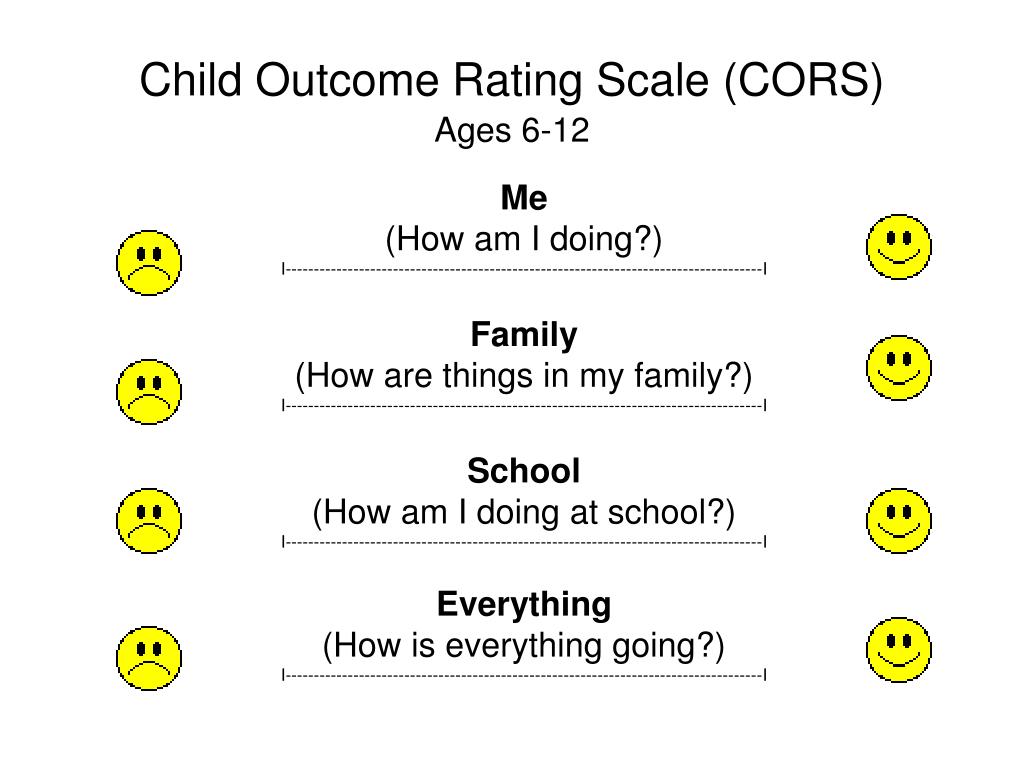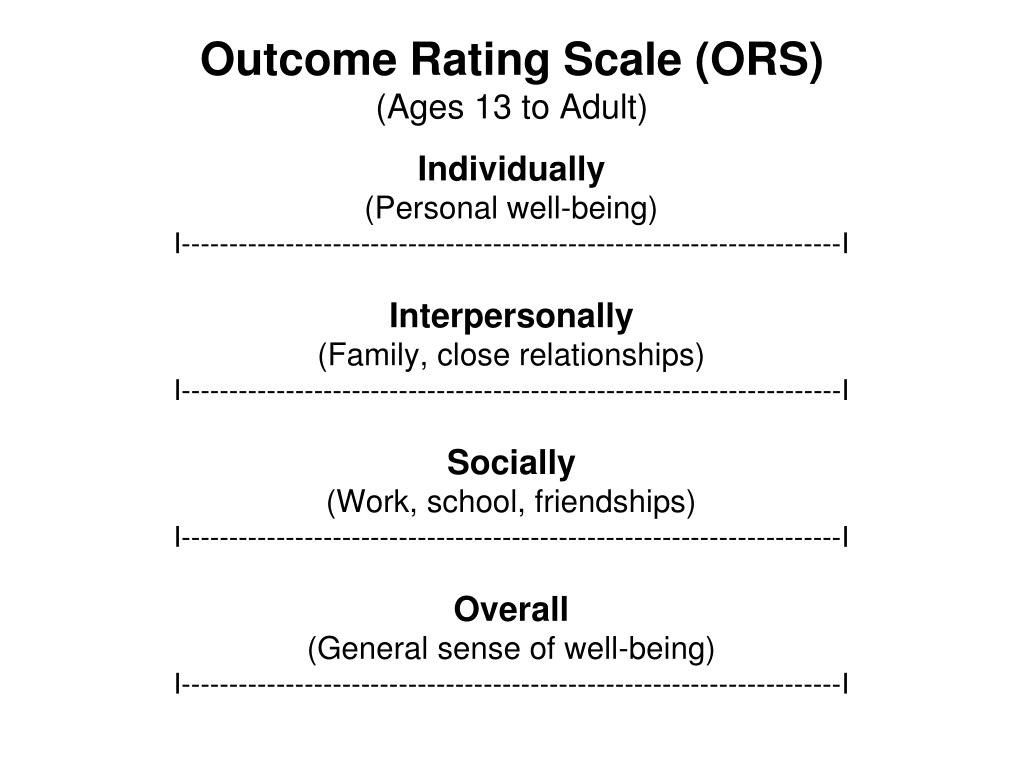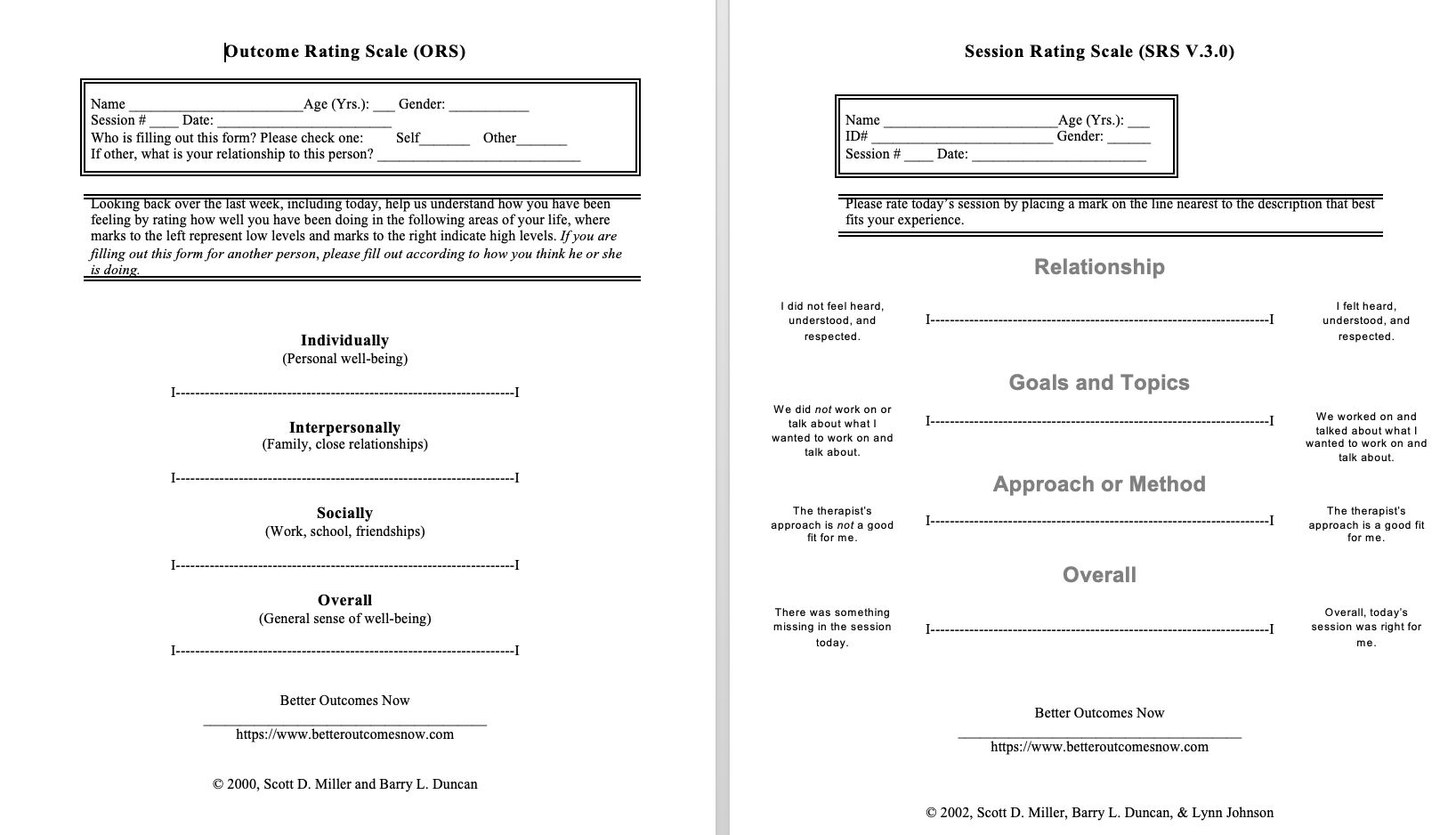
The Rating Scale... Download Scientific Diagram
The Rating of Outcome Scale (ROS; Seidel et al., 2017) was developed as a brief patient-reported outcome measure of patient progress in psychotherapy. The ROS is a 3-item measure of well-being using an 11-point Likert-type response format. The scale takes less than 30 s to administer and 2-4 s to score by hand. Clients are instructed to fill in one of the circled numbers from 0 to 10 for.

The First SelfRated Measure for Children The Child
ORS and SRS rating scales were developed to honor the client's frame of reference and to encourage clinicians to discuss outcome and alliance. Learn more.

PPT Session by Session Monitoring of and Alliance PowerPoint
outcome rating scales and session rating scales This appendix provides outcome rating scales and session rating scales. These scales are for illustration purposes only. The actual scales, which include 10-centimeter lines for each item, may be downloaded from http://www.scottdmiller.com. Note.

The Rating Scale. Source Reprinted with permission. For
The Outcome Rating Scale (ORS) You might also think that the last thing you need is to add more paperwork to your practice. But finding out who is and isn't responding to therapy need not be cumbersome. In fact, it only takes a minute. Dissatisfied with the complexity, length, and user- unfriendliness of existing outcome measures, we developed.

The Rating Scale. Download Scientific Diagram
For two decades, the Outcome Rating Scale (ORS) has repeatedly been proven to be a reliable and valid therapeutic instrument that can be easily and effectively incorporated into any therapist-client session (Miller, Duncan, Brown, Sparks, & Claud, 2003; Bringhurst, Watson, Miller, & Duncan, 2006; Campbell & Hemsley, 2009).

The Rating Scale. Source Reprinted with permission. For
92 Outcome Rating Scale JBT 2(2) pp. 91-100 2/3/04 10:51 AM Page 92 intermittent rather than consistent use of the scale from session to session, pr oblems with

Made to measure The Rating Scale Therapy Meets Numbers
Outcome Rating Scale (ORS) Name ________________________Age (Yrs):____ Gender_____________ Session # ____ Date: ________________________ Who is filling out this form? Please check one: Self_______ Other_______ If other, what is your relationship to this person? ____________________________

Rating Scale Printable Fill Online, Printable, Fillable
Journal of Brief Therapy Volume 2, Number 2 • Spring/Summer 2003 The Outcome Rating Scale: A Preliminary Study of the Reliability, Validity, and Feasibility of a Brief Visual Analog Measure Scott D. Miller, PhD Barry L. Duncan, PsyD Institute for the Study of Therapeutic Change Chicago, Illinois Jeb Brown, PhD

PPT Session by Session Monitoring of and Alliance PowerPoint
The Outcome Rating Scale (ORS) is a highly effective tool to track and measure a client's progress during therapy. Using an ORS is an essential component of Feedback-Informed Treatment (FIT), providing critical information to the therapist about the client's: Functioning in different life domains. The ORS is a brief, four-item visual analog.

Total Rating Scale Score (ORS) and Total Session Rating Scale
The Outcome Rating Scale (ORS), the measure of the Partners for Change Outcome Management System ( PCOMS ), is quite different than other outcome instruments. It is an outcome measure, but it is also a valuable clinical tool that requires nuance in its use.

Child Rating Scale CORS Greenspace (CA)
Best Practices for Using Rating Scales to Measure Mental Health. Rating scales, sometimes called progress monitoring tools, stand among the easiest outcome measures to implement within a practice. A good rating scale will have a strong scientific foundation, and along with being practical, reliable, and valid, will be sensitive to patient changes.
Made to measure The Rating Scale Therapy Meets Numbers
What is an Outcome Rating Scale (ORS)? The is a self-report tool used to measure change. It helps healthcare professionals evaluate an individual's perspective of improvement. It can be used at various points during therapy or to track progress over a longer period. The ORS also looks at how the individual is doing in three main domains:

Rating Scale (ORS) / Échelle d’évaluation des résultats (EER
Outcome Rating Scale (ORS) and Session Rating Scale (SRS). The ORS and the SRS each consist of four items in visual analogue format. For each item, the respondent is instructed to place a. Journal of Brief Therapy, 7(1 &2), 2010 Hafkenscheid, Duncan & Miller Dutch ORS and SRS 3

Rating Scale (ORS) Explained
Describing Outcome Scales (RAI-MDS 2.0) This scale can be used as a clinical screen for depression. Calgary Depression Scale (CDS). A score of 3 or more may indicate a potential or actual problem with depression. This scale detects frailty and health instability and was designed to identify residents at risk of serious decline.

ORS and SRS Rating Scales Path to Development
Outcome Rating Scale scoring helps the client and therapist to reach a shared understanding of the issue at hand and of what success could look like. Following the first session, the client and therapist can compare the most recent score with those from previous sessions and raise the critical question: "Are things better or not?"

The webbased Rating Scale (ORS) (top) and graph with ORS
The Outcome Rating Scale (ORS) and Child Outcome Rating Scale (CORS) are measures used to monitor children's, young people and their families' or carers' feedback on therapeutic progress. The ORS is a simple, four-item session-by-session measure designed to assess areas of life functioning known to change as a result of therapeutic intervention.